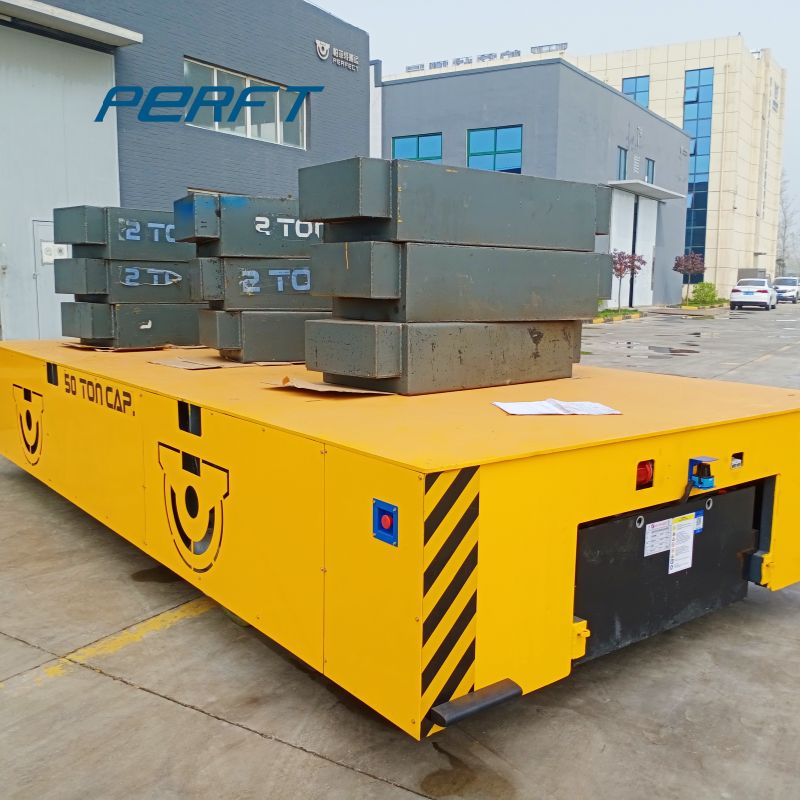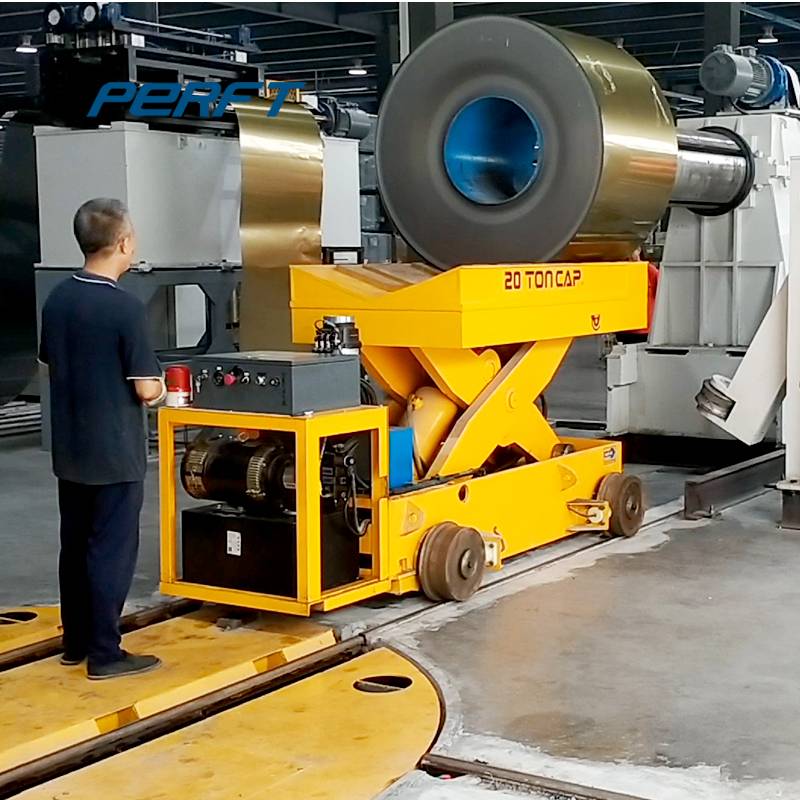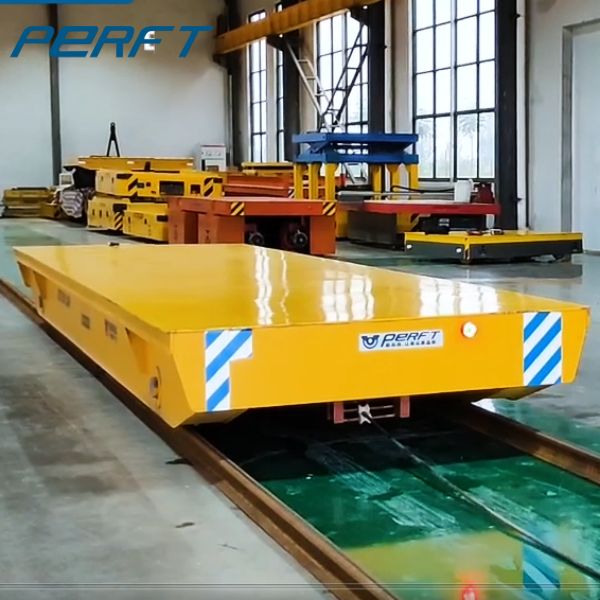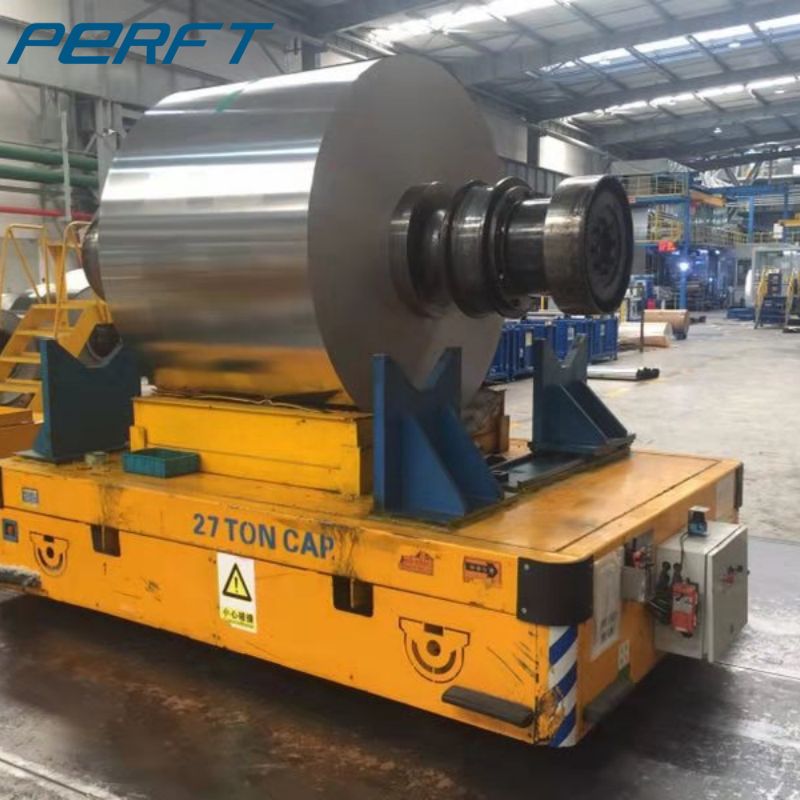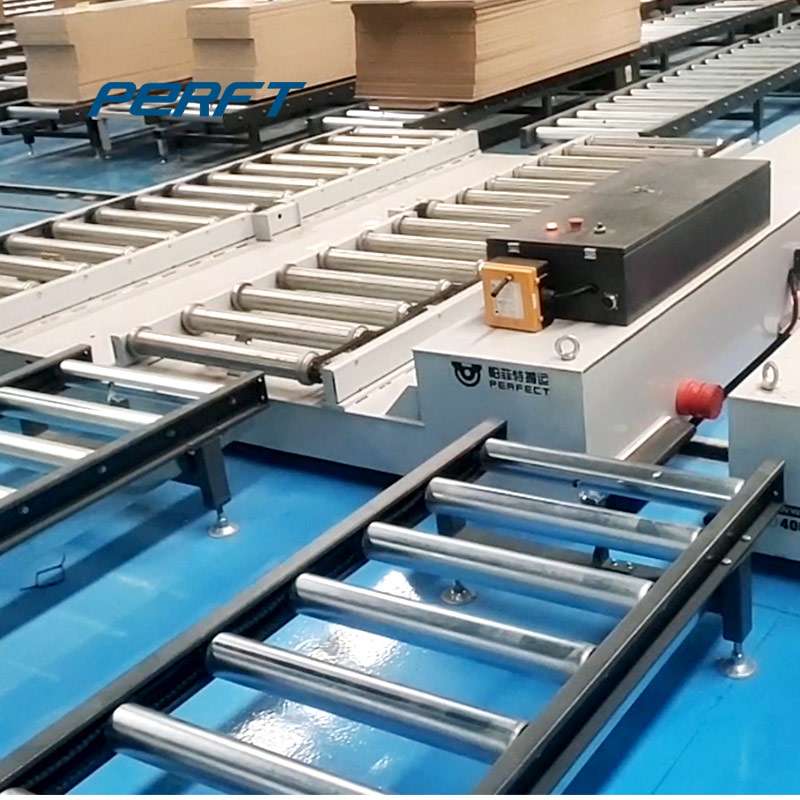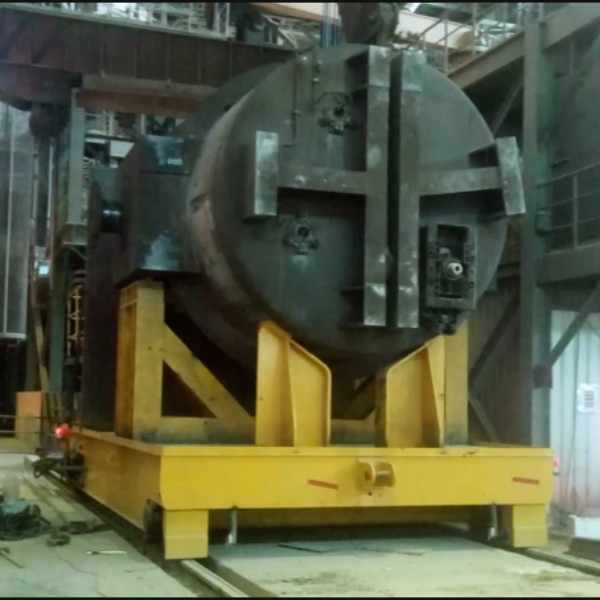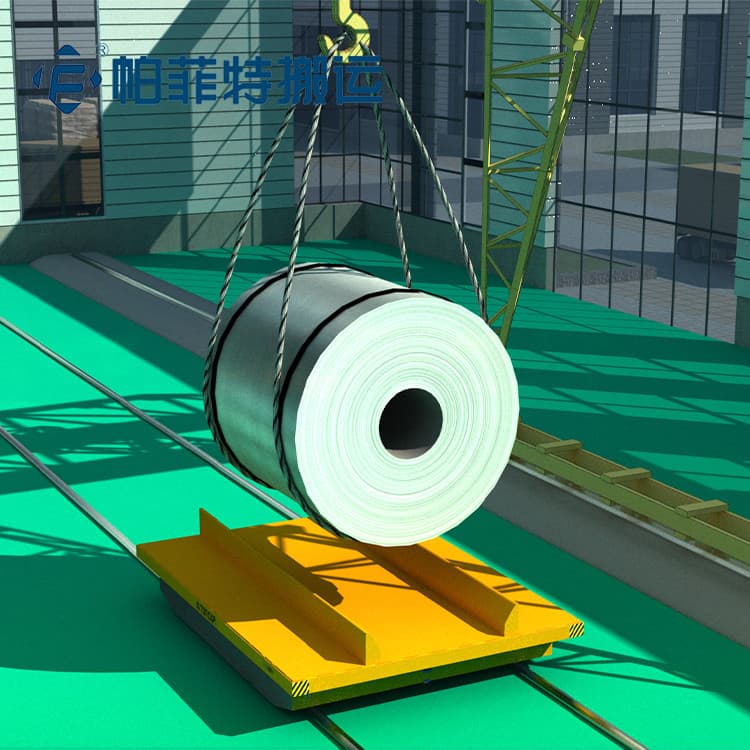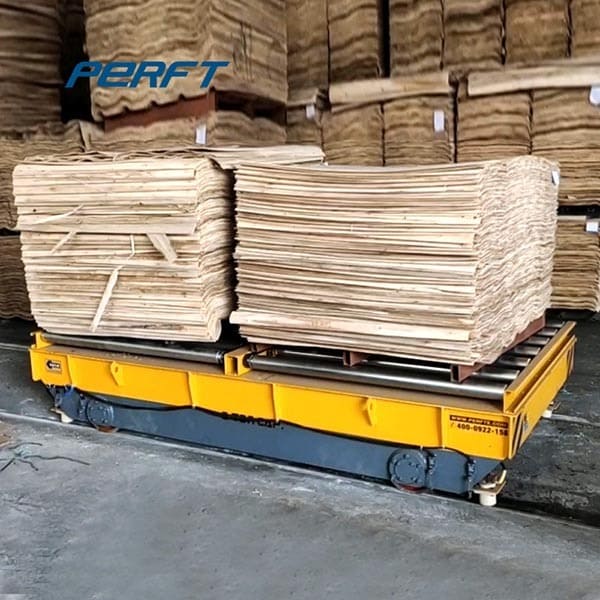Custom Transfer Carts
1. Types of Custom Transfer Carts
The diversity of industrial handling needs dictates that transfer carts need to have different types to meet different handling needs. In general, custom transfer carts can be divided into several types:
Custom rail transfer carts: transfer carts need to rely on tracks to move back and forth on a fixed route, and can be customized according to the original tracks, or new tracks can be built on the infrastructure.
Custom trackless transfer carts: Trackless transfer carts can run flexibly in the handling place, the handling route may not be fixed, and the size, handling capacity and additional functions can be flexibly customized according to the site, so the handling activities are more flexible and maneuverable.
Custom low-voltage powered rail transfer carts: Mainly used for power supply equipment with low-voltage needs of transport places, the voltage will be reduced to a safe voltage of 36V, suitable for large load capacity, the use of high frequency of places, of course, also need to have track support, in a fixed transport route activities.
Custom battery powered transfer carts: Battery powered transfer carts are more flexible, safer and simpler to use in the space of the transfer site without the pulling of the power supply lines. The size of the battery can be customized according to the length of the work. Compared to other transfer vehicles, it is also simpler and easier to maintain.
Custom busbar powered transfer carts: Slip wire powered transfer carts are also mostly required to be transported in the track of a fixed transport route. A new groove in the middle of the track is required to install the busbar powered facility. This type of transfer car can be used in high temperature environments and is ideal for high frequency use.
Custom cable reel powered transfer carts: Cable reel transfer carts are more suitable for harsh environments, high-temperature environments, explosion-proof environments, etc. The car body mechanism is relatively simple, so the cost is lower compared to other models. It is suitable for any load weight and high frequency of use, and the maximum running distance can meet 200-400 meters.
Custom trailing cable powered transfer carts: similar to cable reel transfer carts, the running distance of trailing cable transfer carts is not long, suitable for occasions with higher frequency of use and lower height of the whole car. To avoid the abrasion of the cable, it can be equipped with a drag chain for protection.
2. Benefits of Using Custom Transfer Carts
Greater Efficiency
Custom transfer carts greatly increase workplace productivity in industrial environments. They decrease the amount of physically taxing and time-consuming jobs by automating the movement of big items. This automation simplifies procedures, which speeds up material handling, enhances the production process, and boosts productivity as a whole.
Increased Safety
Every business should prioritize safety, and personalized transfer carts help create that environment. To avoid collisions and accidents, these carts have safety measures like brakes, sensors, and sirens. Employees may confidently operate transfer carts, lowering the chance of accidents and property damage, with the correct training and adherence to safety measures.
Adaptability and Flexibility
Custom transfer carts are adaptable, enabling firms to modify them to meet their particular needs. They can be modified to support special load weights, sizes, and shapes. Additionally, they are suited for a variety of applications and situations due to characteristics like changeable platforms, lift mechanisms, and modular designs that increase flexibility and adaptability.
Cost Reduction
Businesses can save a lot of money by using specialized transfer carts in their material handling procedures. These carts replace the forklifts or cranes, which lowers the cost of equipment operation and maintenance. Additionally, they operate efficiently, which cuts down on manpower.
3. How to Choose A Custom Transfer Cart
You can customize a custom transfer cart to fit your needs by doing the following:
- Capacity for Load
The transfer cart’s load capacity, which defines the heaviest weight it can carry safely, is very important. Determine the heaviest load you plan to transport and choose a cart that can handle that weight. To make sure the cart can support the weight during both stationary and moving operations, it’s crucial to take into account both the static and dynamic load capacities. - Adaptability
Take into account the design of your facility and the particular paths the transfer cart must take. To estimate the required maneuverability of the cart, evaluate the area that is available, the aisles, and the corners. Pick a cart with the right turning radius, steering system, and wheels or tracks for the terrain at your site. - Mechanics
A big part of enhancing worker productivity and safety is ergonomics. Try to find transfer carts with ergonomic features like height-adjustable platforms, adjustable handles, and simple controls. These characteristics guarantee operators can control the cart safely and comfortably, lowering the possibility of accidents and weariness. - Resilience
Take into account the transfer cart’s structure and durability, especially if it will be used in a harsh area. Search for carts built of sturdy materials like aluminum or heavy-duty steel. The cart has a longer lifespan and can resist the rigors of regular use thanks to its robust design. - Source of Power
Custom transfer carts may be powered by batteries, electricity, or even compressed air, among other things. Analyze the power sources that are available and easily accessible in your building. Electric carts give constant power, while battery-powered carts offer flexibility. Select the power supply that most closely matches your operational needs. - Safety Elements
Make that the transfer cart has enough safety precautions in place to safeguard the users and the items they are transporting. Look for features like safety sensors, audio alerts, visual indicators, and emergency stop buttons. These safety precautions aid in avoiding mishaps, crashes, and harm to the cart or neighboring machinery. - Options for Customization
Check to see whether the transfer cart can be customized to meet your unique demands if the manufacturer offers such a service. Adjustable platforms, specific attachments, and additional safety measures are examples of customization features. Having a cart that is specially made for your specific needs can maximize its practicality and effectiveness.
4. Custom Transfer Cart Design and Engineering
A customized transfer cart is designed and engineered using a detailed process to match the unique needs and specifications of a company or industry. The design and engineering stages are essential because they establish the framework for a reliable and effective transfer cart. The following are the main steps in the design and engineering of a custom transfer cart:
1. Needs Analysis
Assessing the particular demands and requirements of the business or industry is the first stage. This entails being aware of the kinds of loads that must be moved, the particular setting in which the cart will be used, the intended weight capacity, the need for maneuverability, and any special safety issues.
2. Design Conceptualization
The design process starts with developing conceptual ideas for the transfer cart when the needs analysis is finished. In order to do this, preliminary design concepts that cater to the specified needs must be sketched out. At this stage, elements including size, shape, mobility, and load-bearing capability are taken into account.
3. In-depth engineering
The detailed engineering phase is the next step after the conceptual design is complete. To do this, precise 2D or 3D CAD (computer-aided design) models of the transfer cart must be created. The engineering team concentrates on elements like structural integrity, load distribution, comfort, safety measures, and compatibility with existing infrastructure.
4. Material Choice
For the transfer cart to be strong, long-lasting, and durable, it is essential to choose the right materials. Materials that can endure the predicted load capacity, weather conditions, and operational requirements are carefully chosen by the engineering team. Due to their strength and durability, premium metals like steel and aluminum are frequently utilized in construction.
5. Control and Power Systems
A crucial factor to take into account is the transfer cart’s power source and control system. The cart may be built to run on batteries, electricity, or another power source, depending on the particular requirements. To ensure smooth and accurate operation, the control system has parts including motor controllers, sensors, and user interfaces.
6. Safety Elements
A crucial component of designing a custom transfer cart is incorporating safety elements. Emergency stop buttons, safety sensors, audible and visible alarms, and safety interlocks are a few examples of safety considerations. These characteristics are intended to safeguard users, avert mishaps, and guarantee the secure transfer of goods.
7. Testing and prototyping
A prototype of the customized transfer cart is constructed after the design and engineering phases are finished. The performance, functionality, and ergonomics of the cart can be tested in real-world settings and evaluated. Before going into production, testing enables the discovery of any design problems or potential improvement areas.
5. Custom Transfer Cart Maintenance and Repair
For custom transfer carts to perform at their best and last as long as possible, maintenance and repair are essential components. Regular upkeep and prompt repairs help to spot possible problems, stop breakdowns, and increase the equipment’s lifespan. Here are some important things to keep in mind when maintaining and fixing unique transfer carts:
1. Consistent Inspections
Check the transfer cart frequently for any indications of wear, damage, or dysfunction. Examine the wheels, axles, steering, power, and safety equipment. Inspect the machine for any worn-out parts, loose bolts, or unusual vibrations or noises while it is in use.
2. Lubrication and cleaning
Maintain the transfer cart in a clean, dust-free, and debris-free condition to avoid impeding its functionality. Keep the cart’s surfaces, wheels, and moving parts clean on a regular basis. To maintain smooth movement and avoid excessive friction or wear, apply the proper lubrication.
3. Battery maintenance
If the transfer cart runs on batteries, maintaining the batteries properly is crucial. Keep your battery in good condition by charging it frequently, cleaning the terminals, and keeping an eye on the fluid level. If necessary, replace exhausted batteries to maintain peak performance.
4. Replacement of a component
Some transfer cart parts might need to be replaced if they start to wear out over time. Maintain a supply of spare parts and vulnerable parts, such as belts, bearings, wheels, and control system components. Any defective or worn-out components should be replaced right away to avoid future harm or safety hazards.
5. Checks of the electrical system
If the transfer cart is powered by electricity, examine the wiring, connections, and control systems on a regular basis. Make sure that all electrical parts are adequately insulated and that there are no exposed wires or weak connections. Hire a licensed electrician to handle any required electrical upkeep or repairs.
6. Testing of Safety Systems
Test the transfer cart’s emergency stop buttons, sensors, alarms, and interlocks on a regular basis. Make sure that these safety systems are responsive and fully operational. To ensure a safe working environment, address any faulty safety features as soon as possible.
7. Operator Education
Give the operators who are in charge of operating and maintaining the transfer cart thorough training. Teach them how to operate machinery safely, and how to do standard maintenance. Encourage users to report any anomalies or issues they notice while using the cart.
8. Records and paperwork
Keep thorough records of all maintenance procedures, fixes, and component replacements. Keep a record of all inspection and repair dates as well as any other pertinent details pertaining to the transfer cart’s maintenance history. This documentation makes it easier to keep track of maintenance schedules, spot reoccurring problems, and verify that maintenance procedures are being followed.
9. Employ expert services.
It could be required to hire expert services or get in touch with the manufacturer for complicated maintenance or repair work. They can offer specialist knowledge, diagnostic equipment, and access to original replacement parts. The transfer cart may be properly maintained and repaired with the aid of professional maintenance and repair services.
